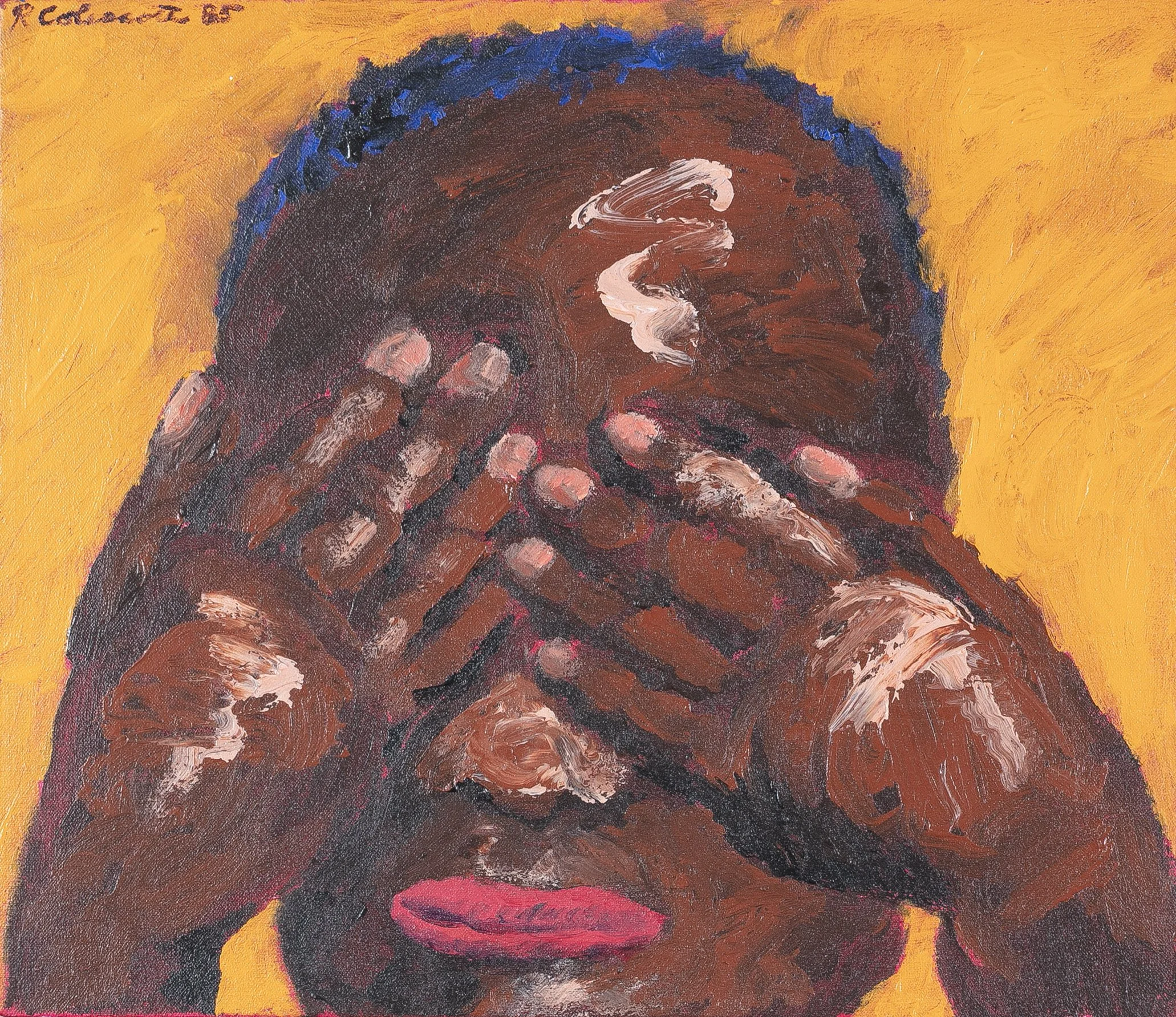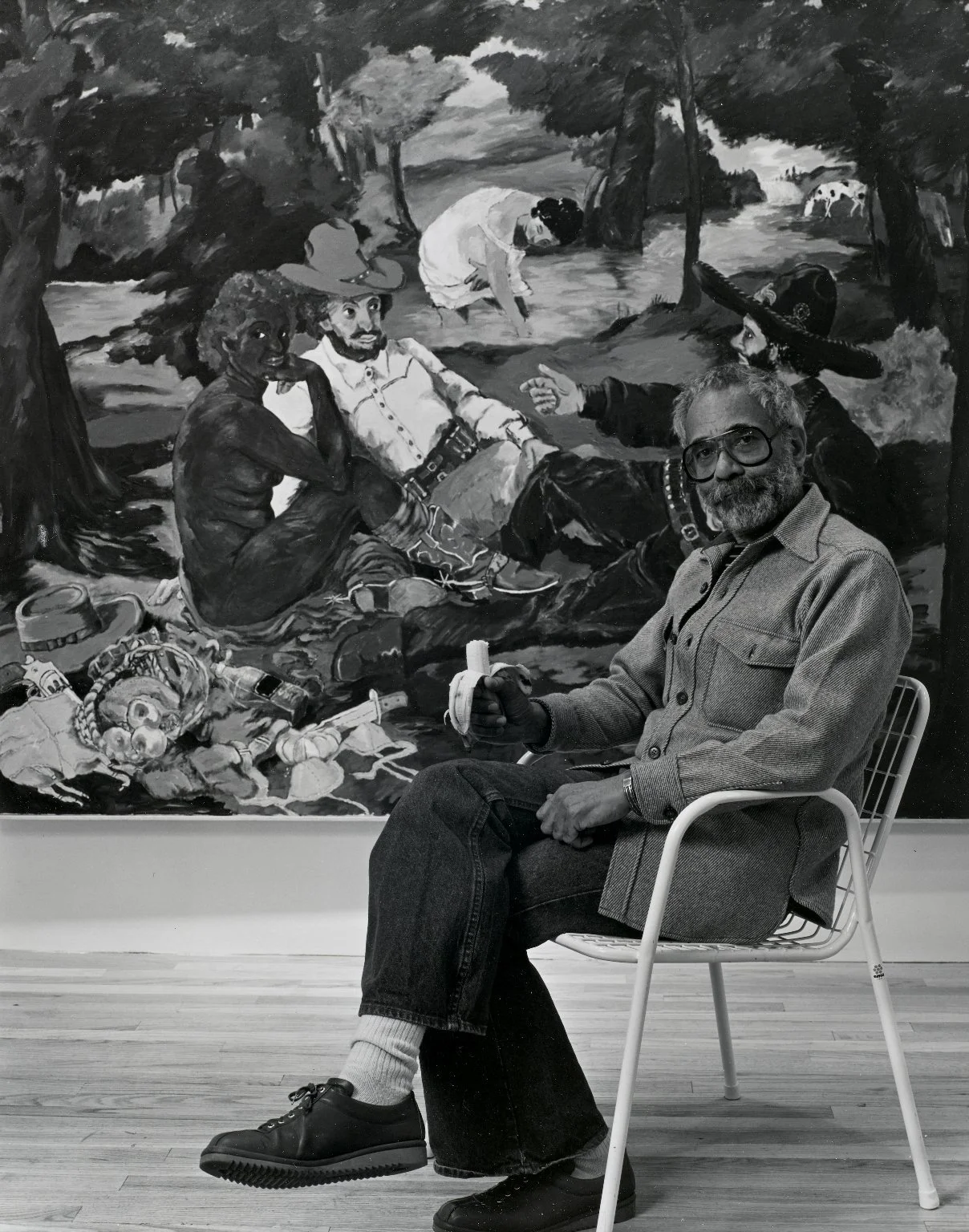
Robert
Colescott
(1925-2009)
Paintings I Promised Never to Paint: Man Crying
1965
oil on canvas
12 x 14 inches
signed and dated
Robert Colescott’s art is a fearless, provocative, and often bitingly humorous exploration of race, gender, and cultural identity in America. Born in Oakland, California, Colescott studied at UC Berkeley (B.A. 1949, M.A. 1952) and in Paris with Fernand Léger, whose emphasis on form and bold color left a lasting imprint on his visual language. Early in his career, Colescott painted semi-abstract figural compositions influenced by modernist traditions, but his time teaching in Cairo in the 1960s expanded his sense of historical narrative and monumentality, prompting a lifelong engagement with myth, parody, and social critique.
By the 1970s, Colescott had developed the highly charged, narrative-figurative style for which he became celebrated. His re-imagined “Old Master” paintings, such as Eat Dem Taters (1974) and George Washington Carver Crossing the Delaware (1975), satirized canonical art history by inserting Black figures into Eurocentric narratives, exposing the racialized underpinnings of Western culture and its visual hierarchies. With garish color, exaggerated anatomy, and biting wit, Colescott used humor as both a weapon and a mirror, forcing viewers to confront America’s contradictions around race, beauty, and history.
The three works in James Parker’s collection, executed in charcoal and lithography during the 1980s, illuminate a more intimate and introspective side of Colescott’s practice. Stripped of the lurid color and busy compositions of his canvases, these monochrome images reveal his draftsmanship and his sensitivity to the human form. In the large charcoal study, Colescott’s sculptural modeling and expressive line echo his training under Léger but carry a looser, more psychological weight. The figures appear mid-gesture, entangled in ambiguous relationships that oscillate between tenderness and tension. In the lithographs, his mark becomes freer and more improvisational, echoing the jazz sensibility that underlies much of his work. The exaggerated eyes, lips, and hair recall the racial caricatures he often subverted, but here they are softened by empathy, humanized through touch and intimacy rather than satire.
Arthur Mones (American, 1919-1998). Robert Colescott, 1981. Gelatin silver photograph, sheet: 14 x 10 3/4 in. (35.6 x 27.2 cm). Brooklyn Museum, Gift of the artist, 1997.162.14. © Estate of Arthur Mones.
These drawings and prints can be read as private rehearsals for his larger themes: the complexity of representation, the fraught gaze between Black and white, male and female, and the artist’s ongoing negotiation between humor and humanity. The final painting among the group, a head pressed behind outstretched hands, distills Colescott’s characteristic mix of bold color and psychological tension. The gesture of concealment reads as both defense and revelation, a poignant metaphor for his career-long project of making America look at what it prefers not to see.
In 1997, Colescott became the first African American artist to represent the United States with a solo exhibition at the Venice Biennale, a milestone that underscored his influence on generations of artists. His work, now held in major collections including the Smithsonian American Art Museum, the Whitney Museum of American Art, and the Museum of Modern Art, continues to resonate for its daring confrontation of stereotype and power through figuration and narrative.
Colescott’s oeuvre spans the spectrum from social critique to personal introspection, and these works capture the quieter heartbeat of an artist who used satire not to mock, but to reveal.
untitled, Ladies in Waiting
1986
charcoal drawing on paper
61 x 42 inches
signed and dated
untitled
1989
lithograph
9-1/2 x 6-1/4 inches (image), full margins
signed, dated, with AP
blindstamp
untitled
1989
lithograph
9-1/2 x 6-1/4 inches (image), full margins
signed, dated, with AP
blindstamp
Selected
Exhibitions
West Coast 74: The Black Image, E.B. Crocker Art Gallery and Los Angeles, Barnsdall Municipal Art Gallery, Sacramento, CA, 1974
ROBERT COLESCOTT: A Retrospective, 1975-1986, San Jose Museum of Art, CA, 1987
Robert Colescott; Phyllis Kind Gallery, Chicago, IL, 1987, 1989, 1990-92
Prisoners of Image. Ethnic and Gender Stereotypes from 1800-1988, Alternative Museum, NY, 1989
Introspectives: Contemporary Art by Americans and Brazilians of African Descent, Los Angeles, CA, 1989 (curated by Henry J. Drewal and David C. Driskell.
The Decade Show: Frameworks of Identity in the 1980s, New Museum of Contemporary Art, Museum of Contemporary Hispanic Art, and Studio Museum in Harlem, NY, 1990
Robert Colescott; Brooklyn Museum, NY, 1993
Narratives of African American Art and Identity: The David C. Driskell Collection, University of Maryland Art Gallery, College Park, MD, 1998
Mixing Metaphors: The Aesthetic, the Social and the Political in African American Art, Howard University Gallery of Art, Washington, DC, 2010
This Will Have Been: Art, Love & Politics in the 1980s, Museum of Contemporary Art (MCA), Chicago, IL, 2012
Art and Race Matters: The Career of Robert Colescott; Contemporary Arts Center, Cincinnati; Portland Art Museum, OR; Sarasota Art Museum, FL; Chicago Cultural Center, IL; New Museum, NY; 2019-2022
The Anansean World of Robert Colescott, BLUM, Los Angeles, CA 2025
